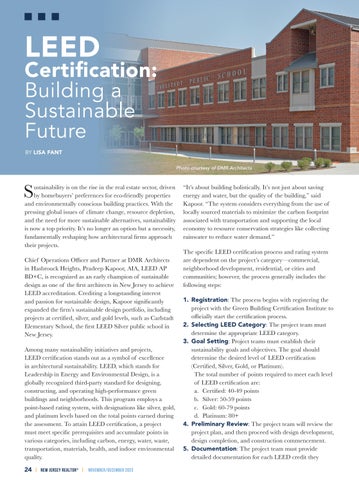LEED
Certification: Building a Sustainable Future BY LISA FANT Photo courtesy of DMR Architects
S
ustainability is on the rise in the real estate sector, driven by homebuyers’ preferences for eco-friendly properties and environmentally conscious building practices. With the pressing global issues of climate change, resource depletion, and the need for more sustainable alternatives, sustainability is now a top priority. It’s no longer an option but a necessity, fundamentally reshaping how architectural firms approach their projects. Chief Operations Officer and Partner at DMR Architects in Hasbrouck Heights, Pradeep Kapoor, AIA, LEED AP BD+C, is recognized as an early champion of sustainable design as one of the first architects in New Jersey to achieve LEED accreditation. Crediting a longstanding interest and passion for sustainable design, Kapoor significantly expanded the firm’s sustainable design portfolio, including projects at certified, silver, and gold levels, such as Carlstadt Elementary School, the first LEED Silver public school in New Jersey. Among many sustainability initiatives and projects, LEED certification stands out as a symbol of excellence in architectural sustainability. LEED, which stands for Leadership in Energy and Environmental Design, is a globally recognized third-party standard for designing, constructing, and operating high-performance green buildings and neighborhoods. This program employs a point-based rating system, with designations like silver, gold, and platinum levels based on the total points earned during the assessment. To attain LEED certification, a project must meet specific prerequisites and accumulate points in various categories, including carbon, energy, water, waste, transportation, materials, health, and indoor environmental quality.
24 | NEW JERSEY REALTOR ® | November/December 2023
“It’s about building holistically. It’s not just about saving energy and water, but the quality of the building,” said Kapoor. “The system considers everything from the use of locally sourced materials to minimize the carbon footprint associated with transportation and supporting the local economy to resource conservation strategies like collecting rainwater to reduce water demand.” The specific LEED certification process and rating system are dependent on the project’s category—commercial, neighborhood development, residential, or cities and communities; however, the process generally includes the following steps: 1. Registration: The process begins with registering the project with the Green Building Certification Institute to officially start the certification process. 2. Selecting LEED Category: The project team must determine the appropriate LEED category. 3. Goal Setting: Project teams must establish their sustainability goals and objectives. The goal should determine the desired level of LEED certification (Certified, Silver, Gold, or Platinum). The total number of points required to meet each level of LEED certification are: a. Certified: 40-49 points b. Silver: 50-59 points c. Gold: 60-79 points d. Platinum: 80+ 4. Preliminary Review: The project team will review the project plan, and then proceed with design development, design completion, and construction commencement. 5. Documentation: The project team must provide detailed documentation for each LEED credit they
